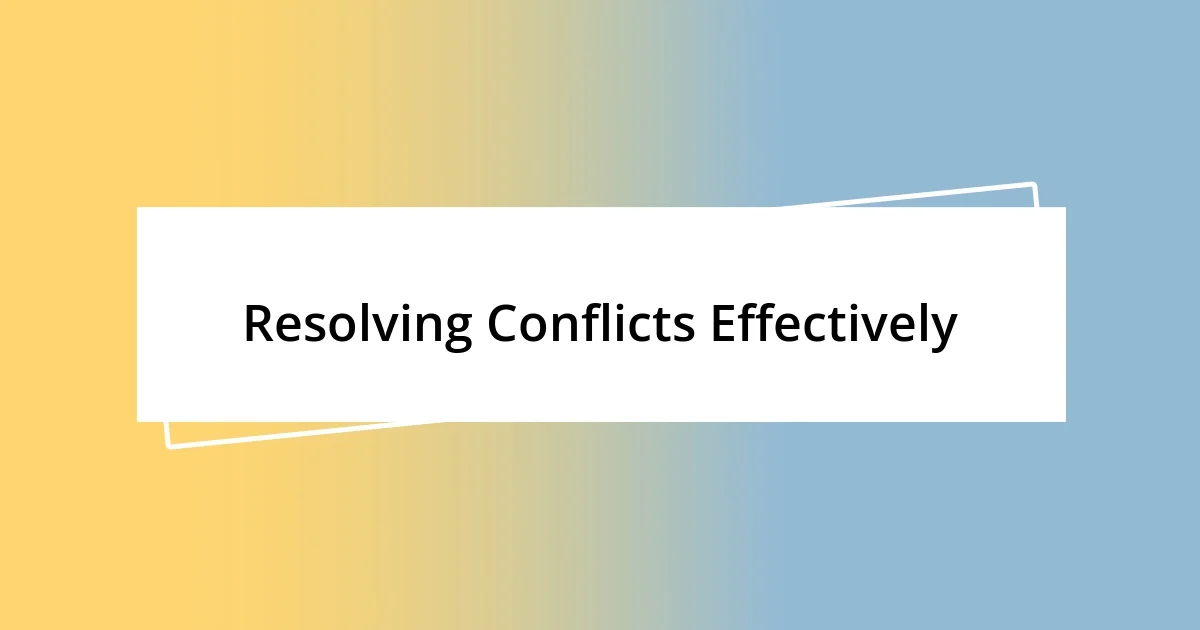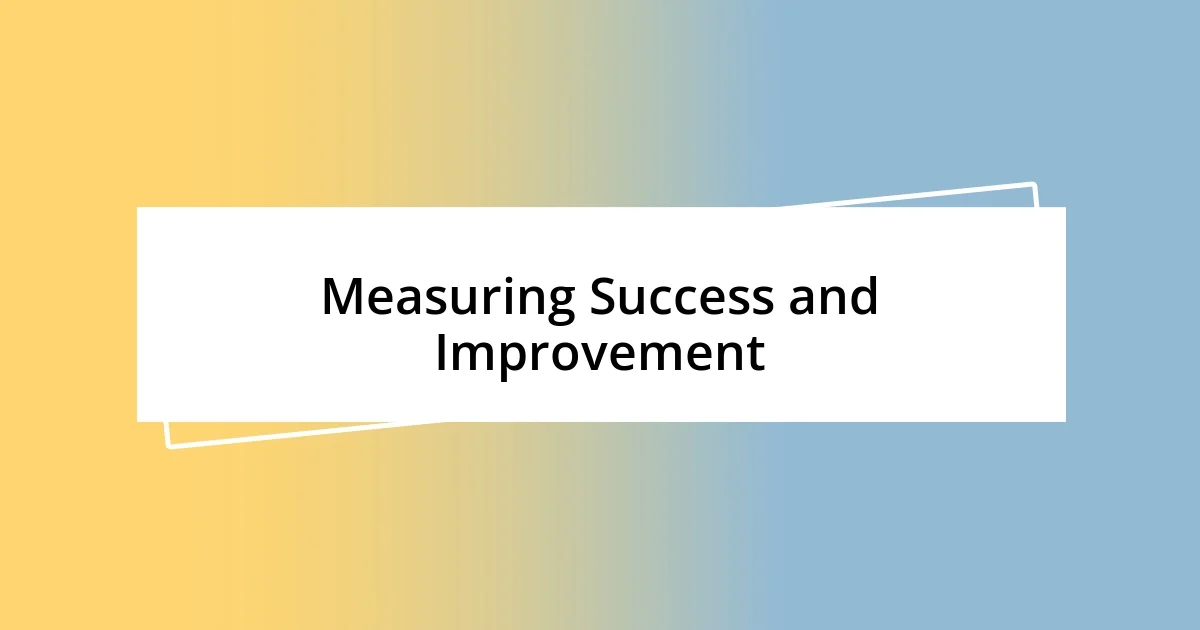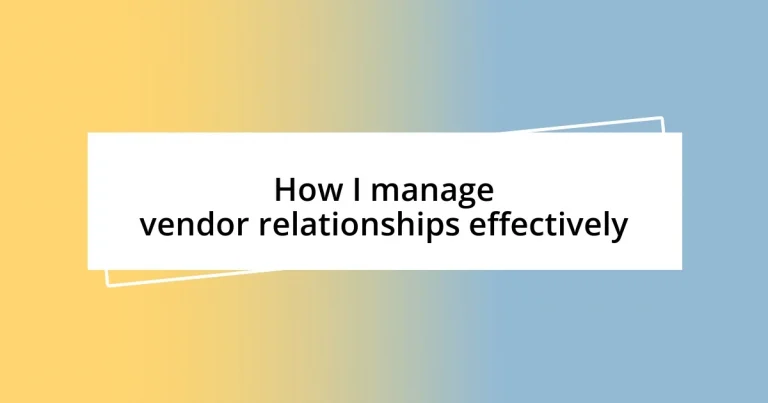Key takeaways:
- Effective communication fosters strong vendor relationships; regular check-ins and transparency about expectations enhance collaboration.
- Building trust involves consistent follow-through and understanding vendor challenges, promoting a supportive environment during difficult times.
- Measuring success through performance metrics and celebrating small wins strengthens partnerships and encourages mutual commitment to excellence.

Understanding Vendor Relationships
Understanding vendor relationships is crucial for any successful business strategy. From my experience, these relationships are not just transactional; they embody partnership. When I think back to my early days, I realize how often I underestimated the emotional dynamics at play. Have you ever considered how trust can significantly impact the collaboration with your vendors?
I remember a time when a vendor and I faced a critical deadline together. Instead of communicating only through emails, I picked up the phone. That simple act turned a routine interaction into a collaborative effort, fostering a deeper connection. This tells me that understanding the nuances of communication can transform the way we work with our vendors. Have you tried changing your communication style?
Establishing vendor relationships goes beyond contracts and terms; it’s about shared goals and mutual respect. It’s fascinating to watch how a little appreciation can go a long way. I’ve seen vendors become more responsive and flexible when I take the time to acknowledge their challenges. Isn’t it interesting how a simple thank you can enhance a partnership? By embedding this understanding into our approach, we can create a more harmonious and productive working relationship with our vendors.

Establishing Clear Communication Channels
Effective communication is the bedrock of any successful vendor relationship. I’ve found that setting clear, open channels right from the outset creates a supportive environment where both parties feel valued. For instance, after a few miscommunications with a vendor, I decided to implement weekly check-ins. These moments not only clarified expectations but also allowed us to share challenges and celebrate wins. It was enlightening to see how our partnership strengthened when we both felt heard.
In my experience, the following strategies are vital for establishing clear communication channels:
- Define Preferred Communication Methods: Knowing whether your vendor prefers emails, calls, or messaging apps can make a big difference.
- Set Regular Touchpoints: Regularly scheduled meetings help maintain alignment and address any issues promptly.
- Be Transparent About Expectations: Clearly outlining roles, deadlines, and deliverables reduces misunderstandings.
- Encourage Feedback: Create a culture where both you and your vendor can express concerns or suggestions openly.
- Utilize Collaborative Tools: Platforms like Slack or Trello can keep everyone in sync and informed in real-time.
Taking these steps not only fosters clarity but also builds a solid foundation of trust. I genuinely believe that when both parties are on the same page, it leads to more productive and joyful collaborations.

Setting Expectations and Objectives
Setting objectives and expectations with vendors is essential for cultivating a productive partnership. From my experience, I always find it valuable to outline clear goals at the beginning of our relationship. This not only helps both parties understand their roles but also sets a positive tone for future interactions. Have you ever noticed how clarity can freeze uncertainty? In one instance, I remember drafting a shared project vision document with a vendor, specifying milestones and key deliverables. This led to much smoother progress checks than we had before, making everyone feel more engaged.
When I reflect on the importance of flexibility, I can’t help but think about a past project that took an unexpected turn. Initially, we had strict objectives, but evolving circumstances required us to pivot. I learned that while having set goals is crucial, being open to adapt those expectations has its merits. It enabled our vendor to become more agile, ultimately benefiting both sides. What does your experience say about balancing firmness with flexibility in expectations?
It’s fascinating how setting specific, measurable goals can energize vendors to go above and beyond. Not only does it create accountability, but it also fosters motivation. I once included performance metrics in a contract, alongside shared rewards for exceeding those metrics. The result was astounding—my vendor felt empowered and delivered results that truly impressed us all. Have you explored incorporating performance incentives in your vendor expectations?
| Objective Type | Description |
|---|---|
| Quantitative | Specific numbers or metrics that gauge performance |
| Qualitative | Descriptive goals that enhance quality and partnership |
| Short-term | Immediate goals for quick wins and feedback |
| Long-term | Strategic objectives aligning with overall business vision |

Building Trust and Reliability
Building trust and reliability with vendors isn’t just a nice-to-have; it’s essential for a thriving partnership. In my journey, I’ve learned that trust truly blossoms when both sides uphold commitments consistently. I remember a time when a vendor faced an unexpected delay. Instead of getting frustrated, I appreciated their honesty—transparency during challenging times can be a game-changer. Have you encountered situations where openness made a difference?
In my experience, demonstrating reliability often comes down to follow-through. A simple promise kept can significantly boost confidence in your partnership. For instance, I once committed to providing timely feedback on a vendor’s prototype. I made it a point to stick to my word, even when deadlines loomed. The relief on their side was palpable, and it catalyzed a synergy I hadn’t anticipated. Do you think consistent actions speak louder than words in vendor relationships?
Ultimately, I believe that building trust is a two-way street. I strive to maintain an environment where vendors feel safe sharing their challenges. In one memorable instance, a vendor opened up about personal struggles impacting their work. Instead of assigning blame, I offered assistance, which not only strengthened our bond but also fostered a sense of collaboration. It’s moments like these that remind me: how can we build lasting relationships if we don’t embrace vulnerability together?

Monitoring Performance and Feedback
Monitoring vendor performance and soliciting feedback plays a pivotal role in ensuring that partnerships remain productive and mutually beneficial. I’ve often found that regular check-ins, whether through formal reviews or casual conversations, can reveal valuable insights. For instance, in one project, I scheduled weekly briefings, allowing both my team and the vendor to voice concerns or share successes. It was surprising how much a simple chat could clear the air and strengthen our collaboration.
When it comes to feedback, I believe specificity is key. I remember providing feedback to a vendor on a marketing campaign that didn’t quite hit the mark. Instead of making vague comments, I pointed out specific areas for improvement, backed by data. That conversation not only improved the campaign but also reinforced the idea that constructive criticism, when delivered thoughtfully, can drive exceptional outcomes. Have you ever analyzed how targeted feedback can change the trajectory of a project?
Incorporating performance metrics creates a more objective view of success, but I often reflect on the emotional aspect as well. After a major project launch, I took the time to gather feedback from my vendor on their experience. Some responses were surprising; they appreciated the recognition of their hard work. It brought to light the importance of acknowledging efforts, not just results. How often do we celebrate milestones together in our vendor relations? I’ve come to realize that recognizing achievements can enhance collaboration and encourage a shared sense of ownership in the success of a project.

Resolving Conflicts Effectively
Resolving conflicts effectively requires a blend of active listening and open-mindedness. I’ve personally navigated moments of tension where the key was to ensure both parties felt heard. For instance, during a disagreement with a vendor over a pricing issue, I made it a point to ask open-ended questions, allowing them to express their perspectives fully. It struck me how simply acknowledging their viewpoint laid the groundwork for a more constructive dialogue. Have you ever realized that sometimes, just listening can dissolve tension?
Emphasizing empathy can transform conflict resolution into a collaborative problem-solving experience. I recall a time when a vendor missed a crucial deadline. Instead of immediately focusing on consequences, I invited them to share their challenges. This led to a candid discussion about their capacity pressures, and together we devised a contingency plan. It was enlightening to see how empathy shifted our dynamic from adversarial to cooperative. How do you typically feel when you approach conflicts with a mindset of understanding?
Crafting a win-win solution is often the ultimate goal, but I’ve learned that it takes creativity and compromise. One specific instance involved a vendor who was struggling to meet our quality standards. Rather than simply imposing penalties, I proposed a workshop where we could brainstorm improvements together. The outcome surprised me; not only did we enhance their processes, but it reinforced our partnership and encouraged innovation. It’s moments like these that make me wonder—what if we all approached conflicts as opportunities for growth?

Measuring Success and Improvement
To measure success and improvement in vendor relationships, I often rely on a mix of quantitative metrics and qualitative insights. For example, after a project wraps up, I do a thorough review of key performance indicators (KPIs) such as on-time delivery and adherence to budget. Alongside these numbers, I like to gather anecdotal feedback from my team about their interactions with the vendor. This combination provides a fuller picture of what’s working and what could be better.
One approach that has yielded remarkable results for me is the use of vendor scorecards. I remember creating one for a supplier of ours who was struggling to meet quality standards. By clearly outlining their performance across various categories, I was able to pinpoint exact areas for improvement. What surprised me was how quickly the vendor responded; they appreciated having a clear framework to aim for, which ultimately led to better outcomes for both sides. Have you thought about whether your vendors understand what success looks like from your perspective?
Celebrating small successes can be just as important as assessing metrics. I’ve noticed that when I acknowledge the incremental wins, like a well-executed delivery or an innovative solution a vendor provided, it strengthens our relationship. In one instance, we hit a milestone earlier than anticipated, and I took a moment to express my gratitude during a casual catch-up. The energy shifted; I could see their pride, and it reinforced our mutual commitment to excellence. How often do you take the time to celebrate with your vendors? You might be surprised by the positive ripples it creates in your partnership.














